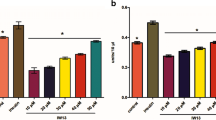Abstract
Disulfide bonds are formed between the sulfhydryl groups in two cysteine residues of a protein. The formation of these bonds is necessary for the proper folding of a protein into its active three-dimensional form. In this study, the genes associated with disulfide bond formation of proteins from the rat thyroid cell line, FRTL-5 cell, were investigated using disulfide bond reducing agent of dithiothreitol (DTT), which prevented disulfide formation of newly synthesized proteins. The expression of six genes, they being the cAMP phosphodiesterase 7A1, neuronal cell death inducible putative kinase (NIPK), cytosolic LIM protein (Ajuba), Eker, early growth response 1 and the ferritin heavy chain, was specifically enhanced under both reductive conditions and various endoplasmic reticulum (ER) stresses inducing drugs such as Brefeldin A (BFA), calcium ionophore A23187 (A23187) and tunicamycin. These results suggest that a suitable redox environment is necessary for the correct disulfide bond conformation in thyrocytes in a complex system.
Similar content being viewed by others
References
Ellis R.J. Discovery of molecular chaperones. Cell Stress Chaperones 1996, 1: 155–160.
Gething M.J. Role and regulation of the ER chaperone BiP. Semin. Cell Dev. Biol. 1999, 10: 465–472.
Mori K. Tripartite management of unfolded proteins in the endoplasmic reticulum. Cell 2000, 101: 451–454.
Kim P.S., Arvan P. Endocrinopathies in the family of endoplasmic reticulum (ER) storage diseases: disorders of protein trafficking and the role of ER molecular chaperones. Endocr. Rev. 1998, 19: 173–202.
Noiva R. Protein disulfide isomerase: the multifunctiona redox chaperone of the endoplasmic reticulum. Semin. Cell Dev. Biol. 1999, 10: 481–493.
Frand A.R., Cuozzo J.W., Kaiser C.A. Pathways for protein disulphide bond formation. Trends Cell Biol. 2000, 10: 203–210.
Doutheil J., Treiman M., Oschlies U., Paschen W. Recovery of neuronal protein synthesis after irreversible inhibition of the endoplasmic reticulum calcium pump. Cell Calcium 1999, 25: 419–428.
Kwon O.Y., Park S., Lee W., You K.H., Kim H., Shong M. TSH regulates a gene expression encoding ERp29, an endoplasmic reticulum stress protein, in the thyrocytes of FRTL-5 cells. FEBS Lett. 2000, 475: 27–30.
Diatchenko L., Lau Y.F., Campbell A.P. et al. Suppression subtractive hybridization: a method for generating differentially regulated or tissue-specific cDNA probes and libraries. Proc. Natl. Acad. Sci. USA 1996, 93: 6025–6030.
Wang P., Wu P., Egan R.W., Billah M.M. Cloning, characterization, and tissue distribution of mouse phosphodiesterase 7A1. Biochem. Biophys. Res. Commun. 2000, 276: 1271–1277.
Mayumi-Matsuda K., Kojima S., Suzuki H., Sakata T. Identification of a novel kinase-like gene induced during neuronal cell death. Biochem. Biophys. Res. Commun. 1999, 258: 260–264.
Kanungo J., Pratt S.J., Marie H., Longmore G.D. Ajuba, a cytosolic LIM protein, shuttles into the nucleus and affects embryonal cell proliferation and fate decisions. Mol. Biol. Cell 2000, 11: 3299–3313.
Xiao G.H., Jin F., Yeung R.S. Germ-line Tsc2 mutation in a dominantly inherited cancer model defines a novel family of rat intracisternal-A particle elements. Oncogene 1995, 11: 81–87.
Yan S.F., Fujita T., Lu J. et al. Egr-1, a master switch coordinating upregulation of divergent gene families underlying ischemic stress. Nat. Med. 2000, 6: 1355–1361.
Orino K., Lehman L, Tsuji Y., Ayaki H., Torti S.V., Torti F.M. Ferritin and the response to oxidative stress. Biochem. J. 2001, 357: 241–247.
Balla G., Jacob H.S., Balla J. et al. Ferritin: a cytoprotective antioxidant strategem of endothelium. J. Biol. Chem. 1992, 267: 18148–18153.
Patil C, Walter P. Intracellular signaling from the endoplasmic reticulum to the nucleus: the unfolded protein response in yeast and mammals. Curr. Opin. Cell Biol. 2001, 13: 349–355.
Author information
Authors and Affiliations
Corresponding author
Rights and permissions
About this article
Cite this article
Park, S., Hwang, I., Shong, M. et al. Identification of genes in thyrocytes regulated by unfolded protein response by using disulfide bond reducing agent of dithiothreitol. J Endocrinol Invest 26, 132–137 (2003). https://doi.org/10.1007/BF03345141
Accepted:
Published:
Issue Date:
DOI: https://doi.org/10.1007/BF03345141




